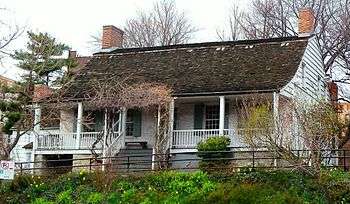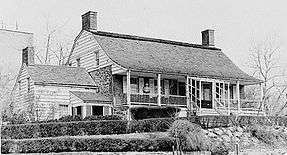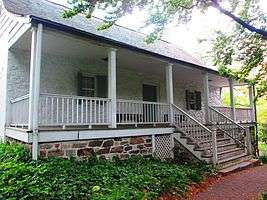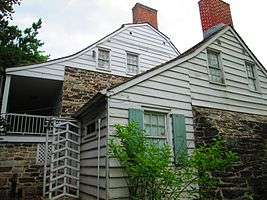Dyckman House
The Dyckman House, now the Dyckman Farmhouse Museum, is the oldest remaining farmhouse on Manhattan island, a vestige of New York City's rural past. The Dutch Colonial-style farmhouse was built by William Dyckman, c.1785,[2] and was originally part of over 250 acres (100 ha) of farmland owned by the family.[4] It is now located in a small park at the corner of Broadway and 204th Street in Inwood, Manhattan.[1]
Dyckman House | |
 (2011) | |
 Dyckman House  Dyckman House  Dyckman House | |
| Location | 4881 Broadway, Inwood, Manhattan, New York City[1] |
|---|---|
| Nearest city | New York City |
| Coordinates | 40°52′2.5″N 73°55′23″W |
| Built | c.1785[2] |
| Architectural style | Dutch Colonial |
| NRHP reference No. | 67000014[3] |
| NYCL No. | 0309 |
| Significant dates | |
| Added to NRHP | December 24, 1967[3] |
| Designated NHL | December 24, 1967[1] |
| Designated NYCL | July 12, 1967 |
History and description
Dyckman was the grandson of Jan Dyckman, who came to the area from Westphalia in 1661.[5] William Dyckman, who inherited the family estate,[4] built the current house to replace the family house located on the Harlem River near the present West 210th Street, which he had built in 1748, and which was destroyed in the American Revolutionary War.[4]

The current two-story house is constructed of fieldstone, brick and white clapboard, and features a gambrel roof and spring eaves. The porches are typical of the Dutch Colonial style, but were added in 1825. The house's interior has parlors and an indoor winter kitchen in the basement, thus serving as a heating for the first floor. The rooms have floors of varying-width chestnut wood.[2][5][6][7] The house's outdoor smokehouse-summer kitchen, in a small building to the south, may predate the house itself.[4][5] The back of the house holds a short hedges that resemble a maze.
The house stayed in the family for several generations until they sold it in 1868, after which it served as a rental property for several decades.[8] By the beginning of the 20th century, the house was in disrepair and in danger of being demolished, and in 1915, the Dyckman family bought it back .[5]
In 1915-16, two sisters of the Dyckman family, Mary Alice Dyckman Dean and Fannie Fredericka Dyckman Welch,[8] began a restoration of the farmhouse under the supervision of architect Alexander M. Welch, Fannie's husband.[2] In 1916, they transferred ownership of the house to the City of New York, which opened it as a museum of Dutch and Colonial life, featuring the original Dyckman family furnishings.[6]
The farmhouse – which is not only the oldest remaining in Manhattan, but the only one in the Dutch Colonial style,[2] and the only 18th-century farmhouse in the borough as well[6] – has been a New York City Landmark and a National Historic Landmark since 1967.[1][9][10]
In 2003, the house underwent a major restoration, after which it re-opened to the public in the fall of 2005.[11]
In popular culture
Gallery
 Front porch
Front porch Rear porch
Rear porch West end of the house, seen from the rear
West end of the house, seen from the rear
See also
References
Notes
- "Dyckman House". National Historic Landmark summary listing. National Park Service. 2007-09-11.
- New York City Landmarks Preservation Commission; Dolkart, Andrew S.; Postal, Matthew A. (2009). Postal, Matthew A. (ed.). Guide to New York City Landmarks (4th ed.). New York: John Wiley & Sons. p. 214. ISBN 978-0-470-28963-1.
- "National Register Information System". National Register of Historic Places. National Park Service. July 9, 2010.
- "Dyckman House Museum" on the New York City Department of Parks and Recreation website
- Kuhn, Jonathan. "Dyckman House" in Jackson, Kenneth T., ed. (2010). The Encyclopedia of New York City (2nd ed.). New Haven: Yale University Press. p. 387. ISBN 978-0-300-11465-2.
- White, Norval; Willensky, Elliot & Leadon, Fran (2010). AIA Guide to New York City (5th ed.). New York: Oxford University Press. p. 575. ISBN 978-0-19538-386-7.
- Federal Writers' Project (1939). "New York City Guide". New York: Random House. p. 304. ISBN 978-1-60354-055-1. (Reprinted by Scholarly Press, 1976; often referred to as WPA Guide to New York City.)
- Historical plaque located near the house. Accessed: May 30, 2014
- ""Dyckman House", by Patricia Heintzelman" (pdf). National Park Service. 1975-10-14. National Register of Historic Places Inventory-Nomination
- "Dyckman House--Accompanying Photos, exterior and interior, from 1967 and 1975" (pdf). National Park Service. September 1978. National Register of Historic Places Inventory
- Dyckman Farmhouse on the Cultural Landscape Foundation website
- Vila, Bob (1996). "Bob Vila's Guide to Historic Homes of America". A&E Network.
External links
| Wikimedia Commons has media related to Dyckman House. |
- Dyckman Farmhouse Museum website
- "Dyckman Farmhouse" on the New York City Department of Parks and Recreation website

